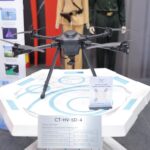
Prime Minister Pham Minh Chinh spoke at the Conference’s conclusion – Photo: VGP/Nhat Bac
|
Prime Minister Pham Minh Chinh stated that to achieve the goal of training 50,000-100,000 engineers for the semiconductor industry, it is necessary to emphasize the following points:
Firstly, it is important to view training and developing human resources for the semiconductor industry as a “breakthrough of breakthroughs” in high-quality human resources training.
Secondly, it is essential to diversify training types, including fundamental training, retraining, conversion training, skills training, doctoral training, domestic and international training, and training through production and business operations.
Thirdly, we need to diversify all resources, including state, social and public resources, promote the relationship between the State, society, and market, and strengthen public-private partnerships.
The Prime Minister also outlined the key tasks and solutions for the upcoming period, including:
Firstly, it is necessary to improve institutions for semiconductor human resources training with specific mechanisms and preferential policies.
Secondly, it is essential to invest in infrastructure for semiconductor human resources training, including training facilities, schools, laboratories, production sites, etc.
Thirdly, it is important to train a team of teachers and lecturers and develop appropriate programs and curricula.
Fourthly, it is crucial to adopt both progressive and innovative training methods, both in the short and long term.
Fifthly, it is necessary to mobilize and diversify resources from the State, schools, enterprises, etc.
The Prime Minister requested that ministries, agencies, localities, enterprises, universities, and relevant stakeholders, based on their functions, tasks, and powers, actively and flexibly develop plans and organize their implementation to deploy specific solutions for the development of the semiconductor human resources sector.
In addition, the Prime Minister expressed his hope that after the conference, relevant stakeholders would raise their awareness, understand their responsibilities, and identify and implement flexible and effective solutions to achieve the goal of training 50,000 – 100,000 human resources for the semiconductor industry by 2030.

Regarding specific tasks, the Prime Minister assigned the Ministry of Planning and Investment to review, finalize, and submit to the competent authority for approval the Project “Developing Human Resources for the Semiconductor Industry by 2030, with a Vision to 2045” with appropriate mechanisms and policies; coordinate with localities in its implementation; and attract foreign investment to develop the domestic semiconductor microchip industry.
The Ministry of Information and Communications should urgently submit to the Prime Minister for approval the Strategy for Developing the Vietnamese Semiconductor Microchip Industry by 2030, with a Vision to 2050.
The Ministry of Education and Training should develop a plan for training semiconductor human resources, formulate cooperation plans, programs, curricula, and provide guidance to training and research institutions to open additional majors, etc.
The Ministry of Science and Technology should promote research, development, and technology transfer for enterprises in the semiconductor chip sector; and direct and guide the implementation of scientific and technological tasks for the semiconductor industry.
The Ministry of Labor, Invalids and Social Affairs should research and propose mechanisms and policies for work permits for foreigners to facilitate the attraction of foreign experts and workers to Vietnam to work in the semiconductor industry; and study ways to promote the formation of a semiconductor labor market within the overall labor market.
The Ministry of Foreign Affairs should promote economic diplomacy to serve the training and attraction of semiconductor human resources, international cooperation, and exchange of experience.
The Ministry of Public Security should study and propose mechanisms and policies for visas, creating favorable conditions for attracting foreign experts in the semiconductor industry in particular and human resources training in general.
The Ministry of National Defense and the Ministry of Public Security should study and direct relevant units such as research institutes, academies, universities, training institutions, defense enterprises, and security forces to participate in implementing programs for training and developing human resources for the semiconductor industry, especially for applications serving national defense and security.
The Ministry of Finance should study and propose to competent authorities revisions to the mechanism for using the State budget to implement the Project and amend and supplement appropriate tax incentive policies.
The State Bank and policy banks should consider and propose special mechanisms and policies for convenient saving and money transfer mechanisms for international experts working in Vietnam in the semiconductor chip sector; and preferential loan policies for students to attract and encourage learning and skill enhancement to serve their work.
The People’s Committees of provinces and centrally-run cities should review, study, and decide on their authority or submit to the competent People’s Councils on allocating budget sources to support scholarships and preferential policies for local students studying semiconductor engineering; and implement the tasks and solutions of the Project.
Universities and vocational training institutions should actively participate and strengthen close cooperation in the relationship between the State, universities, research institutes, innovation and creativity centers, and enterprises; and promote international cooperation.
Enterprises and investors should participate in forming the semiconductor human resources market, actively contribute to the implementation of the Project; closely coordinate with localities and training institutions on training needs and develop training programs; and mobilize and supplement resources with the State to support the Project’s implementation.




































